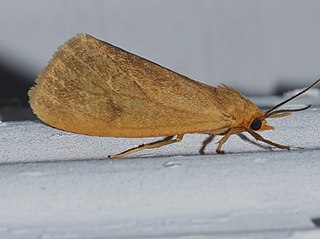
Virbia is a genus of tiger moths in the family Erebidae. The genus was erected by Francis Walker in 1854.

Virbia aurantiaca, the orange holomelina, is a moth species of the family Erebidae found in North America. In the east it has been recorded from Manitoba and Nova Scotia, south along the eastern seaboard to Cordoba in Mexico. It has also been recorded from Texas, Mississippi, Missouri, Tennessee, Louisiana, Oklahoma, Kansas, North Dakota and South Dakota.

Polites vibex, or the whirlabout, is a grass skipper in the family Hesperiidae. The whirlabout gets its name from the landing and take off flight patterns of the adult – a circular or vortex or whirling motion. It is resident from the southeastern U.S. and West Indies to eastern Mexico through the tropics down to Argentina. During the warmer North American months, it can sometimes be found as far north as Ohio, Connecticut, and northeast Iowa.
Caryocolum longiusculum is a moth of the family Gelechiidae. It is found in Afghanistan.
Caryocolum cassella is a moth of the family Gelechiidae. It is found in the France, Germany, Austria, Switzerland, Denmark, Scandinavia, Poland, the Czech Republic, Slovakia, Romania, Estonia, Lithuania, Ukraine, Belarus and Russia. It is also found in North America, where it has been recorded from Alberta, Saskatchewan, California and Nevada. A record from Hokkaido, Japan might also refer to this species.

Caryocolum kroesmanniella is a moth of the family Gelechiidae. It is found from Fennoscandia to the Pyrenees, Alps and Romania and from Great Britain to southern Russia. The habitat consists of open woodland.
Virbia costata is a moth in the family Erebidae. It was described by Richard Harper Stretch in 1884. It is found in the western United States, ranging to western Oklahoma in the east and Colorado in the north.
Virbia fergusoni is a moth in the family Erebidae. It was described by Jennifer M. Zaspel in 2008. It is found in the south-eastern United States, ranging to South Carolina in the north and from Georgia and northern Florida to Alabama in the west. The habitat consists of mixed oak-pine forests.
Virbia ferruginosa, the rusty holomelina, is a moth in the family Erebidae. It was described by Francis Walker in 1854. It is found from Nova Scotia to British Columbia in Canada. In the United States it is found from the northeast and upper Midwest, south to Virginia, Mississippi, Missouri and Louisiana.
Virbia fragilis is a moth in the family Erebidae. It was described by Strecker in 1878. It is found in open fields in the Black Hills in South Dakota and in Boulder, Colorado. The range extends north to Alberta and British Columbia and south to New Mexico.
Virbia immaculata, the immaculate holomelina or plain-winged holomelina, is a moth in the family Erebidae. It was described by Tryon Reakirt in 1864. It is found from the eastern coast of North America west to Manitoba. It has also been recorded in Iowa, Illinois and Indiana.

Virbia laeta, the joyful holomelina, is a moth in the family Erebidae. It was described by Félix Édouard Guérin-Méneville in 1844. It is found in North America from New Brunswick south to Florida and west to Minnesota and south to Texas. The habitat consists of pine woodlands.
Virbia lamae, the bog holomelina, is a moth in the family Erebidae. It was described by Thomas Nesbitt Freeman in 1941. It is found in North America in Nova Scotia, New Brunswick, Maine, Wisconsin and Michigan. The habitat consists of open peat bogs.
Virbia marginata is a moth in the family Erebidae. It was described by Herbert Druce in 1885. It is found in Mexico, Guatemala, Honduras, New Mexico and Arizona.
Virbia nigricans is a moth in the family Erebidae. It was described by Tryon Reakirt in 1864. It is found in the United States in secondary secession habitats of western New Jersey and Pennsylvania.

Virbia opella, the tawny holomelina, is a moth in the family Erebidae. It was described by Augustus Radcliffe Grote in 1863. It is found in the United States from Maine west to Illinois and south to Texas. The habitat consists of oak forests and scrub oak forests.

Virbia ostenta, the showy holomelina, is a moth in the family Erebidae. It was described by Henry Edwards in 1881. It is found in the mountain ranges of New Mexico, Arizona and Mexico.
Virbia rindgei is a moth in the family Erebidae. It is found in Colorado, South Dakota and Wyoming. The habitat consists of ponderosa pine forests.
Dalcerides mesoa is a moth in the family Dalceridae. It was described by Herbert Druce in 1887. It is found in southern Mexico, Guatemala, Costa Rica, Panama, Colombia, Venezuela and Ecuador. The habitat consists of tropical wet, tropical moist, tropical dry, tropical premontane wet, tropical premontane rain, subtropical wet and subtropical dry forests.

Dichomeris juncidella is a moth in the family Gelechiidae. It was described by James Brackenridge Clemens in 1860. It is found in North America, where it has been recorded from Nova Scotia, southern Quebec and southern Ontario to Florida, Texas and Nebraska.







